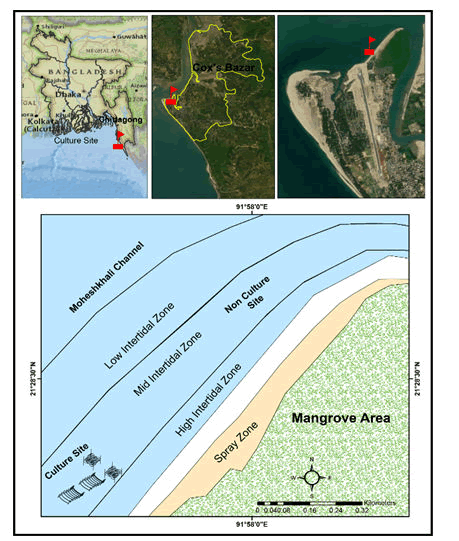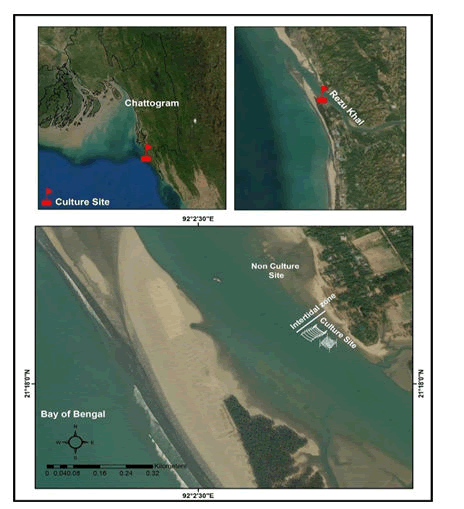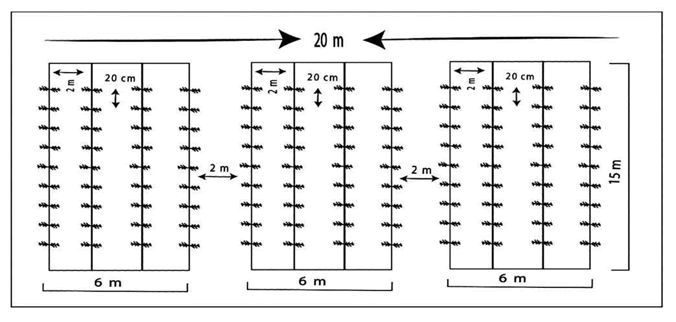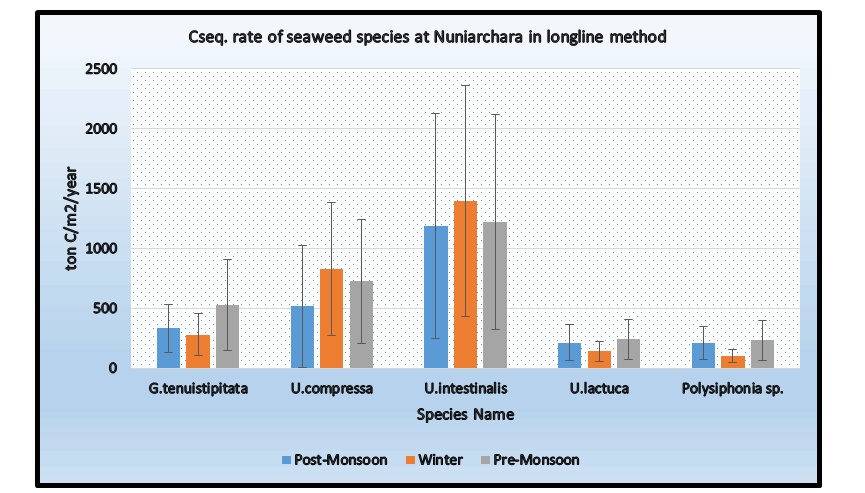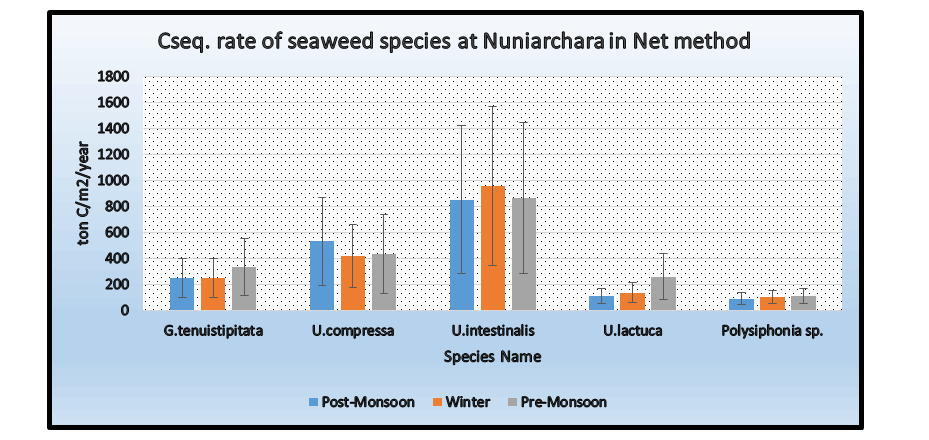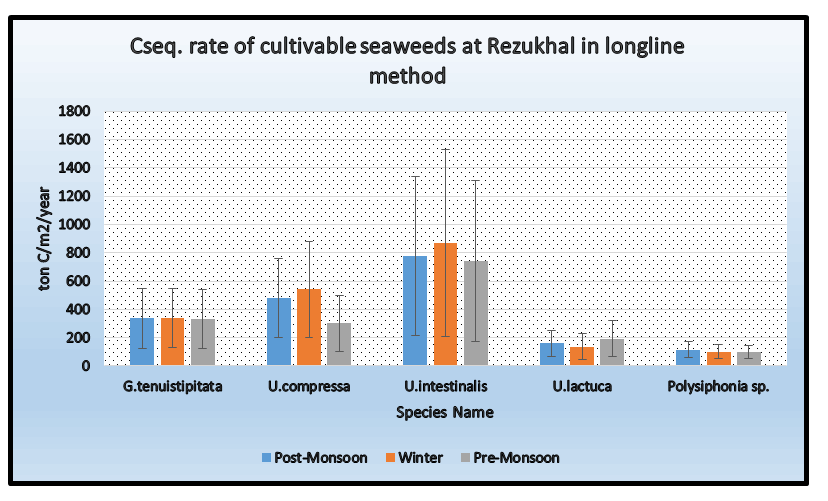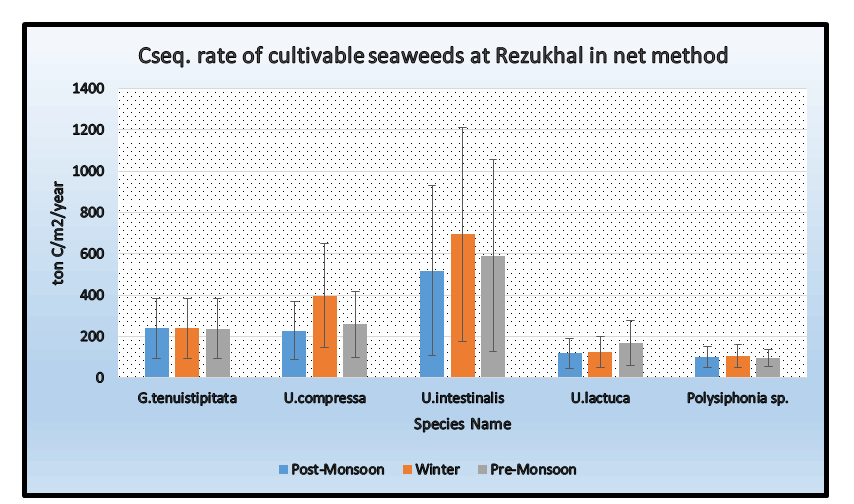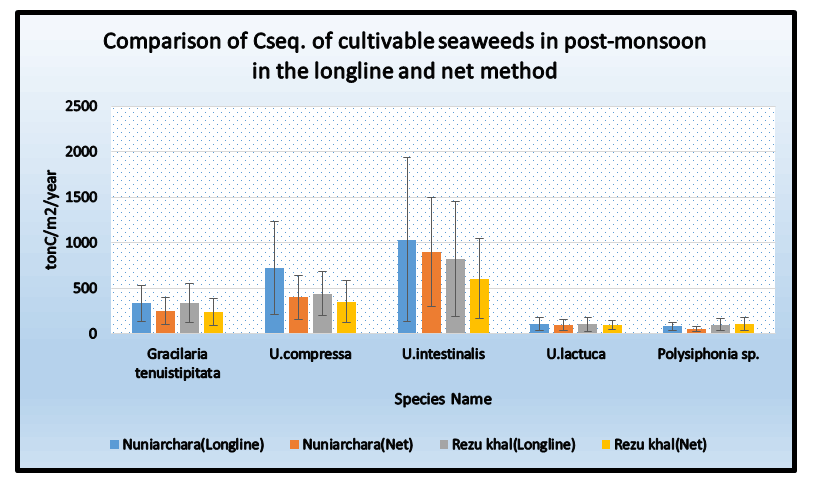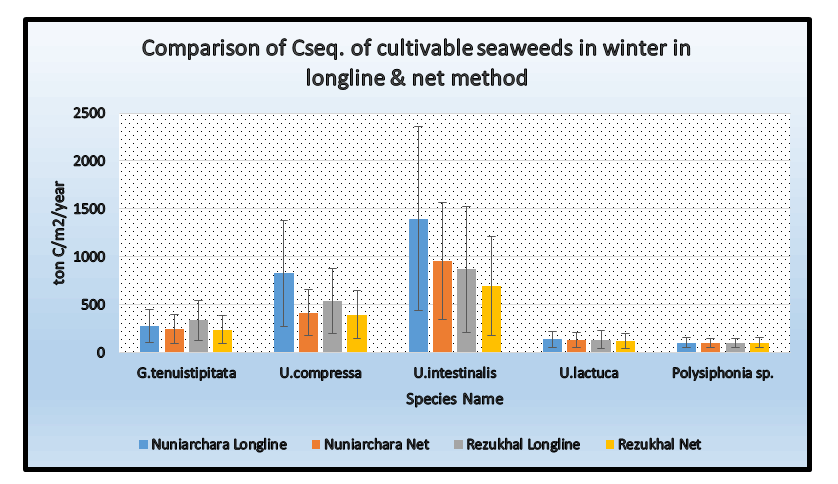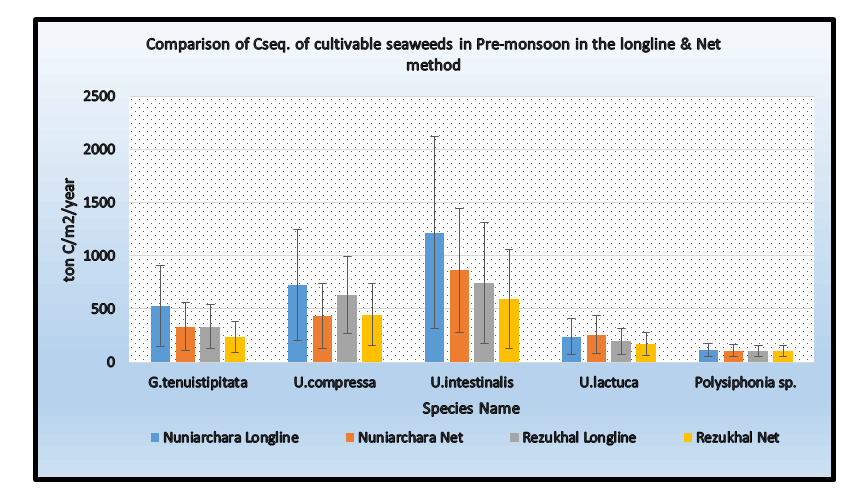Research Article, J Mar Biol Oceanogr Vol: 11 Issue: 4
Assessment Carbon Sequestration Rate of Different Cultivable Seaweeds of Cox’s Bazar Coast, Bangladesh
Mazharul Islam Sajeeb *
Department of Marine Sciences, University of Chittagong, Bangladesh
*Corresponding author: Mazharul Islam Sajeeb, Department of Marine Sciences, University of Chittagong, Bangladesh, Tel: +01521483110; E-mail: sajeebmazharul@gmail.com
Received date: 04 Feb, 2022, Manuscript No. JMBO-22-53533;
Editor assigned date: 07 Feb, 2022, PreQC No. JMBO-22-53533(PQ);
Reviewed date: 21 Feb, 2022, QC No. JMBO-22-53533;
Revised date: 04 Apr, 2022, Manuscript No. JMBO-22-53533(R);
Published date: 11 Apr, 2022, Invoice No. JMBO-22-53533, DOI:10.4172/2324-8661.1000230
Citation: Sajeeb MI (2022) Assessment Carbon Sequestration Rate of Different Cultivable Seaweeds of Coxâ??s Bazar Coast, Bangladesh. J Mar Biol Oceanogr 11:4. Volume 11
Abstract
Seaweed has the ability to use carbon from the environment through photosynthesis to produce biomass. This study aims to estimate the carbon sequestration rate by different cultivable seaweeds as a strategy to mitigate the impact of ocean acidification and global climate change. This study also determines the influence of carbon sequestration on different environmental factors. The study was undertaken at Cox’s Bazar coast. Locally available five seaweed species namely Gracilaria tenuistipitata, Ulva compressa, U. intestinalis, U. lactuca and polysiphonia sp. were cultured with the longline and net method for three cultivation periods, starting from October to March, 2020-2021. Each cultivation period was taken about 45 days. Seaweed samples were collected every 15 days from day 0 (initial), 15,30 to 45 (replanting) for every cultivation period to assess the carbon content of seaweeds. The results show that the sequestration rate of U. intestinalis is significantly higher than the others in the longline and net method. Highest concentration found in the day-45 and lowest concentration is in the day-15. Descending order of the Carbon sequestration in the cultivated seaweeds U. intestanalis>U. compressa>G. tenuistipitata>U. lactuca>Polysiphonia sp. Trends of carbon sequestration rate were influenced by different seaweed variants. Generally, U. intestinalis has higher sequestration rate than other four seaweed variants. Highest concentration found in the day 45 and lowest concentration is in the day 15. Two way-ANOVA results showed the comparisons of the rate of the carbon sequestration among the different cultivated seaweeds at Cox’s Bazar coast among different stations and seasons. Correlation matrix and multiple regression analysis showed the influence of different environmental factors. If the cultures of seaweed increases worldwide in a large scale it will be a powerful tool in controlling ocean acidification and economically benefitted.
Keywords: Blue carbon; Seaweed; Climate change; Post monsoon; Pre-monsoon; Winter
Introduction
Seaweeds are marine macro algae and primitive types of plants, growing abundantly in the shallow waters of the sea, estuaries and backwaters. They flourish wherever rocky, coral or suitable substrata are available for their attachment. They are distributed along coasts from tropical to Polar Regions. They are part of the plantae kingdom and like land plants, seaweed also constitutes the basis of the food chain but in aquatic ecosystems. Among the major primary producers, seaweeds or benthic marine algae grow in the inter-tidal and sub-tidal regions of the sea and contain photosynthetic pigments, which lead them to photosynthesize and produce food. Seaweeds are grouped in three divisions: Brown algae (Ocrophyta-Phaeophyceae), Red algae (Rhodophyta), and Green algae (Chlorophyta). Among seaweed species, the number of red, brown and green seaweed species is 6000, 2000, 1200 respectively.
Seaweeds have been used since ancient times as food, fooder and fertilizer and as a source of medicinal drugs, today seaweeds are the raw material for industrial production of agar, algin, and carrageenan but they continue to be widely consumed as food in Asian countries. They are nutritionally valuable as fresh or dried vegetables, or as ingredients in a wide variety of prepared foods. In particular, certain edible seaweeds contain significant quantities of lipid, protein, vitamins and minerals, although nutrient contents vary with species, geographical location, season and temperature.
CO2 is the main anthropogenic greenhouse gas, if that released into the atmosphere, is responsible for increasing the greenhouse effect leading to global warming. Climate change is caused by the massive increase of GHG (Green House Gases) emission to the atmosphere, for example CO2, which is caused not only from neutral factors but also from human activities (anthropogenic factors) including the burning of fossil fuels and deforestation. The impact of climate change on marine environment is already apparent, such as sea level rise, ocean surface warming, changing course of currents, acidification of surface waters and shifting ranges of natural species.
Climate change mitigation is an important role of seaweed. The impact of climate change on seaweed abundance, distribution and quality is a global concern. Seaweed has a certain degree of resilience to global climate change and its biomass availability can vary on a spatial basis [1,2]. Seaweed acts as a sponge for carbon dioxide and reducing ocean acidification. Gracilaria tikvahiae (red seaweed) and Saccharina latissima (brown seaweed) assimilate carbon rapidly in Long Island Sound and the Bronx River Estuary of NewYork reported that if 0.03% ocean surface area can be cultured then it will be able to remove about 135 million tons of carbon from the ocean water. That means it will remove approximately 3.2% of carbon annually inputted to ocean water from the atmosphere.
CO2 gas is present in considerably higher concentrations in seawater (34-56 ml/l) than in the atmosphere (0.3 ml/l), partially due to the ability of water to absorb more CO2 than air, in equal volume. There has been a good deal of interest in the potential of marine vegetation as a sink for anthropogenic carbon emissions which is known as blue carbon. The concept of blue carbon or atmospheric carbon captured by coastal ecosystems has recently been the focus of reports by UNEP (the United Nations Environment Programme) and IUCN (the International Union for the Conservation of Nature). Seaweed is potential marine vegetation that can use solar energy for the bio-fixation of concentrated CO2 sources from the atmosphere into biomass that can be used to produce phycocolloid compound. These macroalage have the relatively better capability on carbon sequestration than terrestrial plants.
Mass cultivation of seaweeds can be more effective method for CO2 capture and sequestration from the environment because CO2 can be transformed and become more valuable products through photosynthesis. The rate of carbon sequestration by seaweeds would vary depending on the type of seaweed and the climatic conditions in which it was grown.
Human activities have resulted in significant greenhouse gas emissions. Between 1980 and 1989, CO2 emissions from fossil-fuel combustion and tropical deforestation totaled to 7.1 billion tonnes of carbon emitted each year. Carbon dioxide concentration increases in the atmosphere could account for around half of CO2 emissions over this time period.
The ocean has also absorbed huge amounts of human CO2; the quantity of CO2 uptake by the ocean is estimated to be 2 billion tonnes of carbon each year, according to the IPCC (Intergovernmental Panel on Climate Change).
In various parts of Southeast Asia, such as Thailand, the Philippines, Malaysia, and Indonesia, seaweed culture is booming. According to FAO,global seaweed output is expected to be 6 million tonnes per year, worth over $5 billion dollars, with farmed seaweeds accounting for nearly 5% of total global fisheries production. Seaweed aquaculture, the fastest-growing component of global food production, offers a slate of opportunities to mitigate and adapt to climate change. Seaweed farms release carbon that may be buried in sediments or exported to the deep sea, therefore acting as a CO2sink. The crop can also be used, in total or in part, for biofuel production, with a potential CO2mitigation capacity, in terms of avoided emissions from fossil fuels, of about 1,500 tons CO2km−2year−1. Seaweed aquaculture can also help reduce the emissions from agriculture, by improving soil quality substituting synthetic fertilizer and when included in cattle fed, lowering methane emissions from cattle.
Seaweed aquaculture contributes to climate change adaptation by damping wave energy and protecting shorelines and by elevating pH and supplying oxygen to the waters, thereby locally reducing the effects of ocean acidification and de-oxygenation. The scope to expand seaweed aquaculture is, however, limited by the availability of suitable areas and competition for suitable areas with other uses, engineering systems capable of coping with rough conditions offshore and increasing market demand for seaweed products, among other factors. Despite these limitations, seaweed farming practices can be optimized to maximize climate benefits, which may if economically compensated, improve the income of seaweed farmers.
With an annual production of 27.3 million tons in 2014 and a growth rate of 8% year−1, seaweed aquaculture now comprises 27% of total marine aquaculture production. Still, the value of the seaweed produced only amounts to 5% of the total value of aquacultural crops (FAO,2016a). Looking at the process chain of seaweed from production through processing to final products, the growth of the actual seaweed production lags behind the demand of biomass for the many traditional and novel applications for this expanding crop [3,4]. Further expansion of seaweed aquaculture will require the development of a skilled labor force and new technologies to occupy additional suitable areas for farming. Also, diversification of applications will make the industry more resilient to impacts derived from shifting demands from specific industries. A closer synergy between the further expansion of seaweed aquaculture and the development of novel demands for this crop will be essential to continue to fuel the growth of this emerging blue industry. Compensating farmers for the role of seaweed production in climate change mitigation and adaptation need also be considered. Indeed, an increased contribution of seaweed aquaculture to climate change mitigation and adaptation requires that seaweed production continues to grow. However, further growth of seaweed production may drive market prices down, in turn discouraging farmers from engaging in this activity. Thus, providing economic incentives associated with the benefits of climate change mitigation and adaptation may be instrumental in supporting increased seaweed production into the future.
Seaweed production, both from wild stocks and from aquaculture, represents an important conduit for CO2 removal from the atmosphere, with strongly autotrophic seaweed communities globally taking up 1.5 Pg C year−1 via their net production [5]. Yet, the potential of managing seaweed production to mitigate climate change by sequestering CO2 has not yet been fully incorporated into the emergent concept of Blue Carbon, referring to climate change mitigation strategies based on the capacity of marine plants to bind CO2 [6,7,8]. The reason for such neglect is the belief that the large majority of seaweed production is decomposed in the ocean and therefore, does not represent a net sink for CO2. However, this view has been recently challenged [9,10] and new evidence suggests that seaweeds are globally-relevant contributors to oceanic carbon sinks [11]. Hence, the contribution of seaweed to Blue Carbon and climate change mitigation strategies is now being reconsidered.
One pathway to broaden Blue Carbon strategies to incorporate the CO2 sink capacity of seaweeds is to manage the fate of seaweed production, whether derived from aquaculture or harvest of wild stocks, to reduce CO2 emissions derived from fossil fuel use. This can be achieved, for instance, through the use of seaweed biomass as biofuel directly replacing fossil fuels [12,13] and/or replacing food or feed production systems with intense CO2 emission footprints with seaweed-based food systems, which have much lower life-cycle CO2 emission [14]. Indeed, a seaweed-based Blue Carbon program has been developed in Korea [15,16], providing an initial step in this direction. Yet, Korea contributes only 6% of global seaweed aquaculture production (FAO, 2016b), so the development of seaweed farming as a Blue Carbon strategy for climate change mitigation would require that major producers, such as China accounting for more than half of the global seaweed aquaculture production, engage with this strategy.
The development of seaweed farming as a strategy for climate change mitigation would help alleviate present constraints on the further growth of seaweed aquaculture. The growth of seaweed production is exceeding that of traditional markets, leading to a steady decline in price at about 1–2% year−1 [17], deterring farmers and investors from engaging. Economic compensation for the environmental benefits brought about by seaweed farming, including its role in climate change mitigation, would allow for further growth and a more sustainable seaweed aquaculture industry. In particular, economic compensation for climate services associated with seaweed farming would help generate a new market for seaweed production while also creating incentives to reduce further the life-cycle CO2 emissions of seaweed aquaculture.
Here we outline the potential to develop seaweed Blue Carbon Farming as a strategy for climate change mitigation and adaptation. We do so by first assessing the potential, based on wild and aquaculture production and the pathways for this production to be managed as to result in avoidance of CO2 emissions while possibly generating climate change adaptation co-benefits. We then evaluate the role of seaweed aquaculture in adaptation to specific impacts of climate change in the marine environment, such as ocean acidification, deoxygenation and shoreline erosion [18]. Finally, we propose a number of actions required to consolidate such a program as a component of the pathway to solutions for climate change adaptation and mitigation.
Objectives of the study
To assess the carbon sequestration rate of cultivable seaweed this can mitigate the impact of ocean acidification and global climate change.
To show the comparison of carbon sequestration of different cultivable seaweeds between long line and net methods.
To show the relationships among the environmental factors and the rate of carbon sequestration of different cultivable seaweeds at Cox’s Bazar coast.
To know about the physio-chemical parameters comparison with the Carbon sequestration among different cultivable seaweeds of the study area.
Materials and Methods
Study area
The present study was located in the south-eastern coastal waters of Bangladesh, particularly in the Cox’s Bazar coast at Nuniarchara and Rezukhal (Figures 1 and 2).
For measuring the carbon sequestration of different cultivable seaweeds, the experiment was set up at the mid-inter-tidal zone of Nuniarchara (21°28.26´ 31” N, 91°57.51´24” E) coast and the mouth of Rezukhal (21°18.6´64” N, 92°2.41´60” E) in Cox’s Bazar. The Nuniarchara coast is bordered on the northwest by one of the country’s busy Moheskhali channels. On the other hand, Rezukhal is situated in the southern portion of the country and directly open into the ocean.
Two control/reference sites were set associated with the culture site in order to measure the ecological benefits and environmental risks of seaweed cultivation at the Cox’s Bazar coastal area.
Seaweed culture period
The culture period was started from mid-October to mid of March. Three experimental cycles was performed (Table 1).
| Cycle | Plant | Harvest | Date |
|---|---|---|---|
| 1st | 24-Oct | 08-Dec | 24.10.2020-08.12.2020 |
| 2nd | 08-Dec | 22-Jan | 08.12.2020-22.01.2021 |
| 3rd | 22-Jan | 08-Mar | 22.01.2021-08.03.2021 |
Table 1: Cultivation period of seaweed species.
Seaweed is a seasonal product and so it is available during the winter season. So, we planted the seaweeds at the mid of October and it was completed at the mid of March.
Selected Species
In this study, naturally available five seaweed species (Gracilaria tenuistipitata, Ulva lactuca, U. compressa, U. intestinalis and Polysiphonia sp.) were used for cultivation. Two different methods namely long-line and net methods used for cultivation. Young growing fragments of the seaweeds were collected from Nuniarchara and used as initial seedlings. The seedling was done by inserting the young fragments of seaweeds among the rope twisters at 20 cm intervals.
Seaweed Planting
Poly Vinyl Chloride (PVC) rope is used for attaching seaweed seed (seaweed filament). Seaweed was attached in a rope knot with a weight of 10 grams in each knot after an interval of 20 cm from one knot to another. Plastic floats were used to float the seaweeds.
Experimental Setting
Seaweed culture sites were prepared using plastics rope for long lines and coir rope for the net. The size of the long line unit was 15 × 6 m2 which consists of 4 lines/unit. Locally available PVC (plastic) (12 mm) rope was used for the long line. Long line was tied up with bamboo poles tightly and the plastic float was used to hold the line in high tide with bamboo poles so that the setting can stand during high tide. Plastic floats were placed 25 cm above the bottom (Figure 3).
Data collection
Different types of methods are widely employed in seaweed cultivation. Among them are the “Longline method & Net method” where seaweeds are cultivated on suspended lines or ropes. For the present culture experiment, 15 m long line ropes were stretched perpendicularly with the shore. There are 10 linear ropes, 2 lines for one species, as we cultivated 5 species, there were 10 ropes with 137 cm intervals in a plot, and each linear rope was anchored by two bamboo poles on two opposite sides. 2-3 plastic floats were attached with ropes which help them to hover or stay afloat in the water during high tides.
Young seedlings of 8-10 gm in weight and 10-11 cm in length were collected for the initial seedlings. These young seedlings inserted very carefully in the twist of the rope.
Locally available five-seaweed species namely Gracilaria tenuistipitata, Ulva compressa, U. Intestanalis, U. lactuca and Polysiphonia sp. were cultured for measuring carbon sequestration rate in this experiment. The sample was collected every 15 days from day 0 (initial), 15, 30, to 45 (replanting) for every cultivation period. Seaweeds samples were washed and sorted out thoroughly to remove adhered epiphytes or sand and brought to the Institute of Marine Sciences (IMS), University of Chittagong (CU). In the laboratory, samples were gently brushed under running seawater, rinse with distilled water, dried, grind the sample into powder and finally preserved into the airtight vial.
Data calculation
At the subsequent stage the processed sample was stored at -20 Ì?C in the freezer (AOAC manual are followed) and the Carbon Content- were analyzed according to loss of weight on ignition method (FAO, 2008) in IMS, CU laboratory. Finally, the carbon sequestration rate (ton C/m2/year) was estimated by using the formula as follows [19].
Cseq=A × S × P-B ratio × Ccont.
Where, A is a total wide area of seaweed cultivation (m2), S is standing stock (g/m2), P-B ratio is the production-biomass ratio and Ccont is the carbon content (%) [20-25].
Data analysis
All the carbon sequestration data in the present study were expressed in terms of mean ± standard deviation and range [26-30]. Spatio-temporal variations in the value of carbon sequestration rate of different cultivable seaweeds were presented in tabular and graphical form. Variations in the carbon sequestration rate in different cultivable species, seasons, and stations were tested by one-way and two-way ANOVA followed by post hoc Studente Newmane Keuls’s test (a=0.05). The Pearson coefficient (r) was calculated to determine the linear relation between the variables. Statistical analyses were performed with SPSS software (version 23.0). Data analysis was also performed by Microsoft Office Excel [31-35].
Results
The carbon sequestration rate of different cultivable seaweeds at Cox’s Bazar coast using different methods in different seasons and stations was presented in Table 6. This study showed that the sequestration rate of U. intestanalis is significantly higher than the others while the species was cultured in longline method [36-40]. The highest concentration is found on day-45 and the lowest concentration is on day 15. Descending order of the carbon sequestration in the cultivated seaweeds U. intestanalis> U. compressa> G. tenuistipitata> U. lactuca> Polysiphonia sp. (Table 2 and Figure 4). Similarly, the rate of carbon sequestration by U. intestanalis is higher than the others while it was cultured in Nuniarchora using net method (Table 2 and Figure 5).
The highest concentration is found on day-45 and the lowest concentration is on day-15. Descending order of the Carbon sequestration in the cultivated seaweeds U. intestanalis>U.compressa>G.tenuistipitata>U.lactuca>Polysiphoniasp.Thecarbonsequestration rate of different cultivable seaweeds cultured in the Rezukhal site using different methods were presented in Table 2, Figure 6 and Figure 7. Two way-ANOVA results for the comparisons of the rate of the carbon sequestration among the different cultivated seaweeds at Cox’s Bazar coast among different stations and seasons were presented in Table 2.
| Name of the sites | Species | Method | Seasons | ||
|---|---|---|---|---|---|
| Post-monsoon | Winter | Pre-monsoon | |||
| Nuniarchara | Gracilaria | Longline | 331.40 ± 202.72 | 280.37 ± 173.47 | 525.63 ± 382.08 |
| tenuispitata | Net | 248.99 ± 151.43 | 247.70 ± 150.83 | 334.25 ± 221.87 | |
| Ulva compressa | Longline | 827.56 ± 555.93 | 724.38 ± 518.65 | ||
| Net | 417.30 ± 242.99 | 432.96 ± 305.87 | |||
| Ulva intestinalis | Longline | 1396.68 ± 961.91 | 1217.71 ± 899.18 | ||
| Net | 956.24 ± 609.38 | 861.95 ± 582.62 | |||
| Ulva lactuca | Longline | 140.72 ± 84.92 | 239.83 ± 166.76 | ||
| Net | 135.28 ± 79.16 | 259.39 ± 174.45 | |||
| Polysiphonia sp. | Longline | 104.92 ± 54.37 | |||
| Net | 101.14 ± 50.92 | ||||
| Rezukhal | Gracilaria | Longline | 336.91 ± 210.02 | 338.22 ± 209.92 | 334.26 ± 207.82 |
| tenuispitata | Net | 238.39±146.32 | 238.51 ± 146.48 | 237.85 ± 146.28 | |
| Ulva compressa | Longline | 540.75 ± 341.46 | |||
| Net | 396.62 ± 251.53 | ||||
| Ulva intestinalis | Longline | 869.07 ± 660.45 | 742.26 ± 568.69 | ||
| Net | 694.59±517.77 | 590.45±465.45 | |||
| Ulva lactuca | Longline | 136.98±93.23 | 193.77±124.76 | ||
| Net | 123.39 ± 75.25 | 167.94 ± 109.55 | |||
| Polysiphonia sp. | Longline | 100.29 ± 50.95 | |||
| Net | 104.6 ± 54.88 | ||||
Table 2: Rate of Carbon sequestration (ton C/m2/year) of different seaweed species cultivated at different area of Cox’s Bazar coast using different methods.
intestinalis showed the highest carbon concentration and U. lactuca and polysiphonia sp. showed the lowest carbon concentration in the longline method at Nuniarchara. U. intestinalis showed the highest concentration during the winter season. The winter season is most important for all the species for absorbing most carbon [41-45]. In post-monsoon, carbon sequestration is less in the amount in the 5 seaweeds species. In the longline method at Nuniarchara, the overall descending order of seaweed species is U. intestanalis>U. compressa>G. tenuistipitata>U. lactuca>Polysiphonia sp. (Figure 4).
U.intestinalis showed highest carbon concentration and polysiphonia sp. showed lowest carbon concentration in the net method at Nuniarchara. U.intestinalis showed highest concentration during winter season. Winter season is mostly important for all the species for absorbing most carbon. In post-monsoon, carbon sequestration is less in amount in the 5 seaweeds species.In the net method at Nuniarchara the overall descending order of seaweed species is- U. intestanalis>U. compressa>G. tenuistipitata>U. lactuca>Polysiphonia sp.(Figure 5).
intestinalis showed highest carbon concentration and polysiphonia sp. showed lowest carbon concentration in the long line method at Rezukhal. U. intestinalis showed highest concentration during winter season [46-50]. Winter season is mostly important for all the species for absorbing most carbon.In post-monsoon, carbon sequestration is less in amount in the 5 seaweeds species. In the longline method at Rezukhal the overall descending order of seaweed species is- U. intestanalis>U. compressa>G. tenuistipitata>U. lactuca>Polysiphonia sp. (Figure 6).
U.intestinalis showed highest carbon concentration and polysiphonia sp. showed lowest carbon concentration in the net method at Rezukhal. U. intestinalis showed highest concentration during winter season. Winter season and pre-monsoon are mostly important for all the species for absorbing most carbon. In post-monsoon, carbon sequestration is less in amount in the 5 seaweeds species. In the net method at Nuniarchara the overall descending order of seaweed species is U. intestanalis>U. compressa>G. tenuistipitata>U. lactuca>Polysiphonia sp. (Figure 7).
Carbon sequestration was highest in U. intestinalis at Nuniarchara longline method and lowest in Rezukhal net method G. tenuistipitata absorbs most carbon in Rezukhal Longline and lowest in Rezukhal net method U. compressa was highest in Nuniarchara longline and lowest in Rezukhal net U. intestinalis was highest in Nuniarchara longline and lowest in Rezukhal net U. lactuca was highest in Nuniarchara net and Polysiphonia sp was highest in Rezukhal longline [51-55]. Here, Overall in Post-monsoon, longline method is better than the net method and Nuniarchara is more productive than Rezukhal (Figure 8).
Carbon sequestration was highest in U.intestinalis at Nuniarchara longline method and lowest in Rezukhal net method. G. tenuistipitata absorbs most carbon in Rezukhal Longline and lowest in Rezukhal net method U. compressa was highest in Nuniarchara longline and lowest in Rezukhal net U. intestinalis was highest in Nuniarchara longline and lowest in Rezukhal net U. lactuca was highest in Nuniarchara longline and Polysiphonia sp was highest in Nuniarchara longline. Here, Overall in winter, longline method is better than the net method and Nuniarchara is more productive than Rezukhal (Figure 9).
Carbon sequestration was highest in U. intestinalis at Nuniarchara longline method and lowest in Rezukhal net method G. tenuistipitata absorbs most carbon in Nuniarchara Longline and lowest in Rezukhal net method. U. compressa was highest in Nuniarchara longline and lowest in Nuniarchara net U. intestinalis was highest in Nuniarchara longline and lowest in Rezukhal net U. lactuca was highest in Nuniarchara net and Polysiphonia sp. was highest in Nuniarchara longline. Here, Overall in Pre-monsoon, longline method is better than the net method (Figure 10).
Relationships among the environmental factors and the rate of carbon sequestration of different cultivable seaweeds at Cox’s Bazar coast were presented in Table 3.
| Factor | G. tenuistipitata | U. compressa | U. intestinalis | U. lactuca | Polysiphonia sp. |
|---|---|---|---|---|---|
| DO | -.155* | .284* | .379** | -0.206 | .796** |
| pH | .405** | -0.231 | -.302** | .289* | 0.017 |
| TDS | .475** | .253* | 0.224 | .764** | .808** |
| Conductivity | .431** | 0.23 | 0.201 | .703** | .901** |
| Salinity | .373** | 0.073 | 0.032 | .472** | .649** |
| Density | .408** | .273* | -.241* | .681** | .905** |
| Temperature | .280** | 0.13 | 0.047 | .684** | -0.057 |
| Transparency | -.380** | -.250* | -0.187 | -.752** | -.968** |
Table 3: Correlation matrix among the environmental factors and rate of the carbon sequestration of different cultivable seaweeds at Cox’s Bazar coast.
The influence of different environmental factors on the carbon sequestration rate of different cultivated seaweeds at Cox’s Bazar coast were depicted in Table 4.
| Factor | G. tenuistipitata | U. compressa | U. intestinalis | U. lactuca | Polysiphonia sp. |
|---|---|---|---|---|---|
| DO | 0.096 | .872** | 1.147** | 0.241 | .268** |
| pH | -0.183 | -.746** | -.837** | -0.56 | -.076* |
| TDS | 1.354* | 1.039** | 1.383** | 1.730** | -0.355 |
| Conductivity | -1.869** | 0.45 | 1.226* | -0.188 | 1.800** |
| Salinity | -2.224** | 0.304 | 0.685 | -0.144 | 0.011 |
| Density | 3.506** | -1.96 | -3.515** | -1.031 | 0.475 |
| Temperature | .667** | 0.262 | -0.036 | -169 | -.469* |
| Transparency | -0.03 | -1.128* | -1.605** | -1.088** | 0.612 |
| **1% level of significance;*5% level of significance with ß-coefficients values derived from the multiple regression models. | |||||
Table 4: Multiple regression analysis for showing the influence of different environmental factors on the rate of carbon sequestration of different cultivable seaweeds at Cox’s Bazar coast.
A correlation matrix of eight parameters namely DO, pH, TDS, Conductivity, Salinity, Density, Temperature and Transparency was constructed. The correlation coefficient always measures the relationship between the dependent and independent variables. If the correlation coefficient is +1 to -1, it shows the perfect linear relationship between variables. G. tenuistipitata showed a negative correlation with DO and transparency, showed a significant positive correlation with pH, TDS, conductivity, salinity, density, and temperature. U. compressa also had a significant positive correlation with DO, TDS, conductivity, salinity, density and temperature, negative correlation with pH and transparency. U. intestinalis showed a significant positive correlation with DO, TDS, conductivity, salinity and temperature, negative correlation with pH, density, and transparency [56]. U. lactuca showed a significant positive correlation with pH, TDS, conductivity, Salinity, Density, and temperature, negative correlation with DO and transparency. Polysiphonia sp. showed a positive correlation with DO, pH, TDS, conductivity, salinity, density, negative correlation with temperature and transparency (Table 3).
Multiple regression analysis showed the influence of different environmental factors on the rate of carbon sequestration of different cultivable seaweeds at Cox’s Bazar coast. G. tenuistipitata was positively influenced by density and temperature and negatively influenced by conductivity and salinity at 1% level of significance; TDS positively affect the G. tenuistipitata at 5% level of significance. U. compressa was positively influenced by DO and TDS, negatively influenced by pH at 1% level of significance [57]. Transparency negatively influenced U. compressa at 5% level of significance. U. intestinalis was positively influenced by DO, TDS and negatively influenced with pH, density and transparency at 5% level of significance. U. lactuca was positively influenced by TDS and negatively by transparency at 5% level of significance. Polysiphonia sp. positively influenced by DO and conductivity at 5% level of significance and negatively influenced by the temperature at 1% level of significance (Table 4).
Discussion
The capability of four seaweed variants on carbon sequestration was described with the range of carbon sequestration rates. Analyses of variance and Dunean Test showed that seaweed variants indicated significant difference (P<0.05) in influencing seaweed ability on carbon sequestration, either the maximum or minimum values [58-62]. We cultivated 5 different seaweeds in two different methods in two stations (Nuniarchara and Rezukhal). Polysiphonia sp. had the lowest minimum value of carbon sequestration than G. tenuistipitata, U. compressa, U. intestinalis, U. lactuca about 104.6-54.88 ton C/m2/year in Nuniarchara in longline method.
While U.intestinalis showed the highest maximum value of carbon sequestration rate which is significantly different from the other four variants. U. intestinalis has the highest rate of carbon sequestration rate based on maximum values which range about 1396.68-899.18 ton C/m2/year in Nuniarchara in longline method [63].
Carbon sequestration rate has a direct correlation with internal factors of seaweed, including pigment content and growth rate [64-68]. Whereas, the growth rate is influenced by seaweed variants, location and seasonal cultivation periods. Study on 5 different seaweed variants, we observed that U. intestinalis has the highest daily growth rate which is significantly different from others [69-71].
The different capability of seaweeds on carbon sequestration rate was also indicated in different cultivation periods. The statistical analysis result showed a significantly different carbon sequestration rate (P<0.05) among three cultivation periods during this study [72-75]. The second cultivation period indicated a higher rate of carbon sequestration than the other two periods. Seaweeds cultivation which is held during different seasonal cultivation periods would be influenced by temporal variabilities of environmental factors [76]. Seaweeds are exposed to seasonal variations of abiotic factors that influence their metabolic responses, including photosynthetic growth rate [77-80]. Seaweeds absorb CO2 from waters through the photosynthesis process then transformed it into a carbohydrate compound. Good environmental conditions would give higher opportunities to absorb more CO2 from the environment. The higher the CO2 absorbed seaweed, the more productive seaweeds are cultivated [81].
Trends of carbon sequestration rate were influenced by different seaweed variants. Generally, U. intestinalis has a higher sequestration rate than the other four seaweed variants. Analysis of variance showed a significant difference (P<0.05) in the trend of carbon sequestration among seaweed variants [82]. U. intestinalis showed a higher carbon sequestration rate than other species which were cultured in Cox’s Bazar coast in the longline and net method [83].
The trend of carbon sequestration was also different between cultivation periods. Every species showed the most carbon sequestration in the Pre-monsoon period and less carbon sequestration in the winter period [84]. But, between the two methods, longline method showed much carbon sequestration than the net method both in the two stations [85]. Statistical analysis caused a significant difference (P<0.05) in the trend of carbon sequestration between cultivation periods [86]. The second and third periods showed a higher carbon sequestration rate than the first period. The second and third periods were categorized as the productive period for seaweed cultivation, but the first was non-productive. This could be indicated that seaweed's capability on carbon sequestration rate is correlated to cultivation productivity [87].
Generally, U. lactuca and Polysiphonia sp. showed the decreasing trend of carbon sequestration patterns during cultivation. It was at a high rate at the beginning (day 15) then decrease at the end of the cultivation (day 45) on every cultivation period [88]. ANOVA indicated significant differences (P<0.05) of carbon sequestration pattern between seaweed ages at day-15, 30, and 45 of culture [89].
Seaweed cultivation can positively contribute to reducing CO2 from the atmosphere regarding the role of the ocean ecosystem in the blue carbon context. The development of seaweeds aquaculture not only can increase national production but also enhance the economic level of coastal people and improve environmental conditions through its carbon sequestration capability [90-92]. It is interesting to note that 3.5 tons of algae production utilizes 1.27 tons of carbon about 0.22 tons of nitrogen and 0.03 tons of Phosphorus. Carbon sequestration capability positively correlated with seaweed aquaculture productivity. The main aspect that is very important in influencing seaweed aquaculture productivity is the seasonal cultivation period. Moreover, the seasonal aspect will differentiate physical and chemical conditions of water quality parameters, the physical and chemical factors affecting the growth of these plants [93]. The quantity of seaweed production is in line with carbon sequestration volume by seaweed aquaculture. Another important aspect is the selection of seaweed species/variants which are suitable for different specific locations with different environmental conditions [94]. Evaluation of seaweed growth is very important for species suitability selection based on location and planting period. The age of seaweed also influences its performance during the cultivation process.
intestinalis and Gracilaria tenuistipitata showed the highest daily growth rate at the beginning of cultivation [95]. Much consideration is needed to arrange a strategy for developing seaweeds aquaculture in order to make this activity become efficient both economically and environmentally. Implementation strategy for climate change mitigation has to consider at least these three important aspects on seaweeds aquaculture development scheme [96]. Seasonal cultivation periods will be different between different areas; different seaweed variants could not always be suitable in any different cultivation areas and different ages of seaweed will be different on carbon sequestration rate [97]. Bangladesh has great potential areas to develop seaweed aquaculture activity for coastal people's economic enhancement. Optimal utilization of the potential area for seaweed aquaculture could reduce a great quantity of CO2 from the atmosphere and help to mitigate the global climate change process [98]. Planning and implementation processes of policy and management of coastal carbon ecosystems for climate change mitigation require that stakeholders and community engaged in both climate change mitigation and coastal activities [99]. Therefore, the government should play a significant role in managing and regulating a way to combine seaweed aquaculture activity as one of coastal community livelihood with awareness of people to do this activity not only for economic interests but also for environmental concern.
Conclusion
Seaweed capability on carbon sequestration could be influenced by seaweeds variants, cultivation periods and seaweed age (day of culture). U. intestinalis had the highest carbon sequestration rate and Polysiphonia sp. had the lowest. Seasonal cultivation periods have also influenced the capabilities of seaweed on carbon sequestration. These were caused by variabilities conditions of environmental factors between different cultivation periods. The implementation strategy for climate change mitigation has to consider at least three important aspects of the seaweeds aquaculture development scheme. Seasonal cultivation periods will be different in any area; different seaweed variants could not always grow well in any different cultivation area and different ages of seaweed would have different capabilities on carbon sequestration.
References
- Hill R, Bellgrove A, Macreadie PI, Petrou K, Beardall J, et al. (2015) Can macroalgae contribute to blue carbon? An Australian perspective.Limnol Oceanogr60: 1689–1706.
- Boden TA, Marland G, Andres RJ (2010) Global, regional, and national fossil-fuel CO2 Carbon Dioxide Information Analysis Center, Oak Ridge National Laboratory, U.S. Department of Energy, Oak Ridge.
- Mazarrasa I, Olsen YS, Mayol E, Marba N, Duarte CM (2014). Global unbalance in seaweed production, research effort and biotechnology markets.Biotechnol Adv 32:1028–1036.
- Callaway E (2015) Lab staple agar hit by seaweed shortage.Nature528:171–172.
- Krause-Jensen D, Duarte CM (2016) Substantial role of macroalgae in marine carbon sequestration.Nat Geosci 9:737–742.
- Nellemann C, Corcoran E, Duarte CM, Valdes L, De Young C, et al. (2009) Blue carbon: The Role of Healthy Oceans in Binding Carbon. A Rapid Response United Nations Environment Programme, GRID-Arendal.
- Mcleod E, Chmura GL, Bouillon S, Salm R, Bjork M, et al. (2011) A blueprint for blue carbon: towards an improved understanding of the role of vegetated coastal habitats in sequestering CO2.Front Ecol Environ9:552–560.
- Duarte CM, Losada IJ, Hendriks IE, Mazarrasa I, Marba N (2013) The role of coastal plant communities for climate change mitigation and adaptation.Nat Clim Change3:961–968.
- Trevathan-Tackett SM, Kelleway J, Macreadie PI, Beardall J, Ralph P, et al. (2015) Comparison of marine macrophytes for their contributions to blue carbon sequestration.Ecology 96:3043–3057.
- Moreira D, Pires JC (2016) Atmospheric CO2capture by algae: negative carbon dioxide emission path.Bioresour Technol215:371–379.
- Krause-Jensen D, Marba N, Sanz-Martin M, Hendriks IE, Thyrring J, et al. (2016) Long photoperiods sustain high pH in Arctic kelp forests.Sci Adv 2:e1501938.
- Kraan S (2013) Mass-cultivation of carbohydrate rich macroalgae, a possible solution for sustainable biofuel production.Mitigation Adap Strateg Glob Change18:27–46.
- Chen H, Zhou D, Luo G, Zhang S, Chen J (2015) Macroalgae for biofuels production: progress and perspectives.Renew Sust Energ Rev47:427–437.
- Fry JM, Joyce PJ, Aumonier S (2012)Carbon Footprint of Seaweed as a Biofuel. Prepared by Environmental Resources Management Limited (ERM), London for the Crown Estate, 64.
- Chung IK, Oak JH, Lee JA, Shin JA, Kim JG et al. (2013) Installing kelp forests/seaweed beds for mitigation and adaptation against global warming: Korean Project Overview.ICES J Mar Sci70:1038–1044.
- Sondak CF, Chung IK (2015) Potential blue carbon from coastal ecosystems in the Republic of Korea.Ocean Sci J50:1–8.
- Kronen M, Ponia B, Pickering T, Teitelbaum A, Meloti A, et al. (2013) Social and economic dimensions of carrageenan seaweed farming in Solomon Islands. Social and economic dimensions of carrageenan seaweed farming.Fish Aqua Tech 580:147–161.
- Gattuso JP, Magnan A, Bille R, Cheung WW, Howes EL, et al. (2015) Contrasting futures for ocean and society from different anthropogenic CO2emissions scenarios.Science349:aac4722.
- Erlania, Radiarta IN (2015) The use of seaweeds aquaculture for carbon sequestration: A strategy for climate change mitigation. J Geod and Geomat Eng 2:109-115.
[Crossref]
- Alvarado-Morales M, Boldrin A, Karakashev DB, Holdt SL, Angelidaki I, et al. (2013) Life cycle assessment of biofuel production from brown seaweed in Nordic conditions.Biores Technol129:92–99.
- Baghel RS, Reddy CR, Jha B (2014) Characterization of saprophytic seaweeds from the biorefinery context. Bioresour Technol159:280–285.
- Barron C, Duarte CM (2015) Dissolved organic carbon pools and export from the coastal ocean. Glob Biogeochem Cycles 29:1725–1738.
- Barron C, Apostolaki ET, Duarte CM (2014) Dissolved organic carbon juxes by seagrass meadows and macroalgal beds. Front Mar Sci 1:42.
- Bikker P, van Krimpen MM, van Wikselaar P, Houweling-Tan B, Scaccia N, et al. (2016) Biorefinery of the green seaweedUlva lactucato produce animal feed, chemicals, and biofuels.J Appl Phycol28:3511–3525.
- Broitman BR, Halpern BS, Gelcich S, Lardies MA, Vargas CA, et al. (2017) Dynamic interactions among boundaries and the expansion of sustainable aquaculture. Front Mar Sci4:15.
- Bruhn A, Torring DB, Thomsen M, Canal-Verges P, Nielsen MM, et al. (2016) Impact of environmental conditions on biomass yield, quality, and bio-mitigation ofSaccharina latissima. Aquac Environ Interact.8:619–636.
- Callaway R, Shinn AP, Grenfell SE, Bron JE, Burnell G, et al. (2012) Review of climate change impacts on marine aquaculture in the UK and Ireland.Aquat Conserv Mar Freshwater Ecosyst22:389–421.
- Chung IK, Beardall J, Mehta S, Sahoo D, Stojkovic S (2011) Using Marine Macroalgae for Carbon Sequestration: A Critical Appraisal. J Appl Phycol 23:877-86.
- Cole AJ, Roberts DA, Garside AL, de Nys R, Paul NA (2016) Seaweed compost for agricultural crop production.J Appl Phycol28:629–642.
- Dawes CJ (1981) Marine Botany. Canada: John Wiley and Sons. Inc.
- Delille B, Borges AV, Delille D (2009) Influence of giant kelp beds (Macrocystis pyrifera) on diel cycles of pCO2and DIC in the Sub-Antarctic coastal area . Estuar Coast Shelf Sci81:114–122.
- Diaz RJ, Rosenberg R (2008) Spreading dead zones and consequences for marine ecosystems.Science321:926–929.
- Dâ??Orazio N, Gemello E, Gammone MA, De Girolamo M, Ficoneri C, et al. (2012) Fucoxanthin: a treasure from the sea.Mar Drugs10:604–616.
- Duarte CM (1992) Nutrient concentration of aquatic plants: patterns across species.Limnol Oceanogr 37:882–889.
- Duarte CM, Cebrian J (1996) The fate of marine autotrophic production.Limnol Oceanogr 41:1758–1766.
- Duarte CM, Holmer M, Olsen Y, Soto D, Marba N, et al. (2009) Will the oceans help feed humanity?. BioScience59:967–976.
- Duarte CM, Middelburg J, Caraco N (2005) Major role of marine vegetation on the oceanic carbon cycle.Biogeosciences 2:1–8.
- Erlania, Nirmala K, Soelistyowati DT (2013) Carbon Absorption in Seaweeds Aquaculture Kappaphycus Alvarezii and Gracilaria Gigasin Gerupuk Bay, Central Lombok, West Nusa " Jurnal Riset Akuakultur 8:287-97.
- Erlania, Radiarta IN (2014) Difference of Seaweed, Kappaphycus Alvarezii, Cultivation Cycles on Variability of Carbon Sequestration Rate. Jurnal Riset Akuakultur 9:111-24.
- Sugama K 2014. "Seasonal Cultivatian Periods of Four Eucheumatoids Seaweeds Variants Performance in Gerupuk Bay, West Nusa Tenggara." Jurnal Riset Akuakultur 9 (2): 331-42. in Indonesian. abstract in English) European 2007. "Climate Change: What Impact on Fisheries?" Fisheries and Aquaculture in Europe 35: 4-6.
- FAO (2016a).The State of World Fisheries and Aquaculture 2016. Contributing to Food Security and Nutrition for All. Rome: FAO.
- FAO (2016b). Fisheries and aquaculture software. FishStat Plus - Universal software for fishery statistical time series," in:FAO Fisheries and Aquaculture DepartmentRome.
- Fernand F, Israel A, Skjermo J, Wichard T, Timmermans KR, et al. Offshore macroalgae biomass for bioenergy production: Environmental aspects, technological achievements and challenges.Renew Sustain Energy Rev.
- Fourqurean JW, Duarte CM, Kennedy H, Marba N, Holmer M, et al. (2012) Seagrass ecosystems as a globally significant carbon stock.Nat Geosci5:505–509.
- Francavilla M, Manara P, Kamaterou P, Monteleone M, Zabaniotou A (2015) Cascade approach of red macroalgaeGracilaria gracilissustainable valorization by extraction of phycobiliproteins and pyrolysis of residue.Bioresource Technol.184, 305–313.
- Gattuso JP, Gentili B, Duarte CM, Kleypas JA, Middelburg JJ, et al. (2006) Light availability in the coastal ocean: impact on the distribution of benthic photosynthetic organisms and their contribution to primary production.Biogeosciences3:489–513.
- Gaylord B, Rosman JH, Reed DC, Koseff JR, Fram J, et al. (2007) Spatial patterns of flow and their modification within and around a giant kelp forest.Limnol Oceanogr52:1838–1852.
- Gimpel A, Stelzenmuller V, Grote B, Buck BH, Floeter J, et al. (2015) A GIS modelling framework to evaluate marine spatial planning scenarios: Co-location of offshore wind farms and aquaculture in the German EEZ.Mar Policy55:102–115.
- Harley CD, Anderson KM, Demes KW, Jorve JP, Kordas RL, et al. (2012) Effects of climate change on global seaweed communities.J Phycol48:1064–1078.
- Harley CDG, Hughes RA, Hultgren KM, Miner BG, Sorte CJB, et al. (2006) The Impacts of Climate Change in Coastal Marine Systems. Ecol Lett 9:228-41.
- Herrero M, Ibanez E (2015) Green processes and sustainability: an overview on the extraction of high added-value products from seaweeds and microalgae.J Supercrit Fluids96:211–216.
- Herr D, Pidgeon E (2012) Guidance for National Blue Carbon Activities: Fast-Tracking National Implementation in Developing Countries. Brief of Third Workshop of International Blue Carbon Policy Working Group–The Blue Carbon
- Hurd Cl (2015) Slow-flow habitats as refugia for coastal calcifiers from ocean acidification.J Phycol51:599–605.
- Solomon S, Qin D, Manning M, Chen Z, Marquis M, et al. IPCC (2007) Summary for Policymakers." In Climate Change 2007: The Physical Science Basis. Contribution of Working Group I to the Fourth Assessment Report of the Intergovernmental Panel on Climate Change, Cambridge: Cambridge University Press.
- Barros V R, Dokken D J, Mach KJ, Mastrandrea MD, Bilir TE, M. et al. IPCC (2014) "Summary for policymakers," inClimate Change 2014: Impacts, Adaptation, and Vulnerability. Part A: Global and Sectoral Aspects. Contribution of Working Group II to the Fifth Assessment Report of the Intergovernmental Panel on Climate Change, eds C. B. Field (Cambridge, UK; New York, NY: Cambridge University Press), 1–32.
- Kaladharan P, Veena S, Vivekanandan E (2009) Carbon Sequestration by a Few Marine Algae: Observation and Projection. J Mar Biol Assoc India 51:107-110.
- Kaspersen BS, Christensen TB, Fredenslund AM, Moller HB, Butts MB, et al. (2016) Linking climate change mitigation and coastal eutrophication management through biogas technology: evidence from a new Danish bioenergy concept.Sci Total Environ541:1124–1131.
- Keeling RE, Kortzinger A, Gruber N (2010) Ocean deoxygenation in a warming world.Mar Sci2:199–229.
- Kerrison PD, Stanley MS, Edwards MD, Black KD, Hughes AD (2015) The cultivation of European kelp for bioenergy: Site and species selection.Biomass Bioenerg80:229–242.
- Kinley RD, de Nys R, Vucko MJ, Machado L, Tomkins NW (2016) The red macroalgaeAsparagopsis taxiformisis a potent natural antimethanogenic that reduces methane production duringin vitrofermentation with rumen fluid.Anim Prod Sci56:282–228.
- Krause-Jensen D, Duarte CM (2014) Expansion of vegetated coastal ecosystems in the future Arctic.Front Mar Sci1:77.
- Krause-Jensen D, Duarte CM, Hendriks IE, Meire L, Blicher ME, et al. (2015) Macroalgae contribute to nested mosaics of pH variability in a sub-Arctic fjord.Biogeoscience12:4895–4911.
- Lehahn Y, Ingle KN, Golberg A (2016) Global potential of offshore and shallow waters macroalgal biorefineries to provide for food, chemicals and energy: feasibility and sustainability. Algal Res17:150–160.
- Lorbeer AJ, Lahnstein J, Bulone V, Nguyen T, Zhang W (2015) Multiple-response optimization of the acidic treatment of the brown algaEcklonia radiatafor the sequential extraction of fucoidan and alginate.Bioresour Technol197:302–309.
- Lovas SM, Torum A (2001) Effect of the kelpLaminaria hyperboreaupon sand dune erosion and water particle velocities.Coast Eng44:37–63.
- Machado L, Magnusson M, Paul NA, Kinley R, de Nys R (2016) Dose-response effects ofAsparagopsis taxiformisandOedogoniumsp. onin vitrofermentation and methane production.J Appl Phycol28:1443–1452.
- Maia MR, Fonseca AJ, Oliveira HM, Mendonca C, Cabrita AR (2016) The potential role of seaweeds in the natural manipulation of rumen fermentation and methane production. Sci Rep6:32321.
- Mak W, Wang SK, Liu T, Hamid N, Li Y, et al. (2014) Anti-proliferation potential and content of fucoidan extracted from sporophyll of New ZealandUndaria pinnatifida.Front Nutr 1:9.
- Makkar HP, Tran G, Heuze V, Giger-Reverdin S, Lessire M, et al. (2016) Seaweeds for livestock diets: a review.Anim Feed Sci Technol212:1–17.
- Martinez E, Sanz F, Pellegrini S, Jimenez E, Blanco J (2009) Life cycle assessment of a multi-megawatt wind turbine.Renew Energy 34:667–673.
- Maslin M (2004) Global Warming: A Very Short Introduction. New York: Oxford University Press Inc.
- Masarin F, Cedeno FR, Chavez EG, De Oliveira LE, Gelli VC et al. (2016) Chemical analysis and biorefinery of red algae Kappaphycus alvarezii for efficient production of glucose from residue of carrageenan extraction process.Biotechnol Biofuels9:122.
- McLaughlan C, Gallardo B, Aldridge DC (2014) How complete is our knowledge of the ecosystem services impacts of Europe's top 10 invasive species?. Acta Oecol54:119–130.
- Middelboe AL, Hansen PJ (2007) High pH in shallow-water macroalgal habitats.Mar Ecol Prog Ser338:107–117.
- Mork M (1996) Wave attenuation due to bottom vegetation, inWaves and Nonlinear Processes in Hydrodynamics, eds J Grue, B Gjevik, J. E. Weber (Oslo: Kluwer Academic Publishing), 371–382.
- Msuya FE (2011). The impact of seaweed farming on the socioeconomic status of coastal communities in Zanzibar, Tanzania.World Aquaculture42, 45–48.
- Muraoka D (2004) Seaweed Resources as a Source of Carbon Fixation.Bull Fish Res Agen 1:59-63.
- Oâ??Doherty JV, Dillon S, Figat S, Callan JJ, Sweeney T (2010) The effects of lactose inclusion and seaweed extract derived fromLaminariaspp. on performance, digestibility of diet components and microbial populations in newly weaned pigs. Anim Feed Sci Technol157:173–180.
- Olafsen T, Winther U, Olsen Y, Skjermo J (2012)Value Created from Productive Oceans in 2050. DKNVS and NTVA.
- O'shea CJ, McAlpine P, Sweeney T, Varley PF, O'doherty JV (2014) Effect of the interaction of seaweed extracts containing laminarin and fucoidan with zinc oxide on the growth performance, digestibility and faecal characteristics of growing piglets.Br J Nutr 111:798–807.
- Parenrengi A, Rachmansyah, Suryati E (2011) Cultivation of Carraginophyte Seaweed. Research Institute for Coastal Aquaculture, Ministry of Marine Affairs and Fisheries Republic of Indonesia Jakarta, 54 (in Indonesian).
- Radulovich R, Umanzor S, Cabrera R, Mata R (2015) Tropical seaweeds for human food, their cultivation and its effect on biodiversity enrichment.Aquaculture436:40–46.
- Ramankutty N, Evan AT, Monfreda C, Foley JA (2008). Farming the planet: 1. Geographic distribution of global agricultural lands in the year 2000.Glob Biogeochem Cycles 22:GB1003.
- Rebours C, Marinho-Soriano E, Zertuche-Gonzalez JA, Hayashi L, Vasquez JA, et al. (2014) Seaweeds: an opportunity for wealth and sustainable livelihood for coastal communities.J Appl Phycol 26:1939–1951.
- Rey-Crespo F, Lopez-Alonso M, Miranda M (2014) The use of seaweed from the Galician coast as a mineral supplement in organic dairy cattle.Animal8:580–586.
- Roberts DA, Paul NA, Dworjanyn SA, Bird MI, de Nys R (2015) Biochar from commercially cultivated seaweed for soil amelioration.Sci Rep5:9665.
- Robertson GP, Paul EA, Harwood RR (2000) Greenhouse gases in intensive agriculture: contributions of individual gases to the radiative forcing of the atmosphere.Science289:922–1925.
- Robledo D, Gasca-Leyva E, Fraga, J. (2013). "Social and economic dimensions of carrageenan seaweed farming in Mexico," inSocial and Economic Dimensions of Carrageenan Seaweed Farming. Fish and Aquac Tech 580.
- Seghetta M, Torring D, Bruhn A, Thomsen M (2016) Bioextraction potential of seaweed in Denmark – An instrument for circular nutrient management.Sci Total Environ 563–564: 513–529.
- Sinha VRP, Fraley L, Chowdhy BS (2001) Carbon Dioxide Utilization and Seaweed Production. In Proceedings of NETL: First National Conference on Carbon Sequestration,6.
- Skjermo J, Rebours C, Chapman A (2014)A New Norwegian Bioeconomy Based on Cultivation and Processing of Seaweeds: Opportunities and R&D Needs.Trondheim: SINTEF Fisheries and Aquaculture. SINTEF A25981.
- Smale DA, Burrows MT, Moore P, O'Connor N, Hawkins SJ (2013) Threats and knowledge gaps for ecosystem services provided by kelp forests: a northeast Atlantic perspective.Ecol Evol3:4016–4038.
- Smith BE (2002) Nitrogenase reveals its inner secrets.Science297:1654–1655.
- Steneck RS, Graham MH, Bourque BJ, Corbett D, Erlandson JM (2002) Kelp forest ecosystems, biodiversity, stability resilience and future.Environ Conserv29:436–459.
- Stevant P, Rebours C, Chapman A (2017) Seaweed aquaculture in Norway: recent industrial developments and future perspectives. Aquacult. Internat 1–18.
- Sulaiman OO, Kader ASA, Magee A, Othman K (2015). Mooring analysis of offshore aquaculture oceanic farming platform for seaweed.J Coast Zone Manag18:399.
- The Fishery Bureau MoA. (2015).China Fishery Statistical Yearbook.Beijing: China Agriculture Press.
- Waycott M, Duarte CM, Carruthers TJ, Orth RJ, Dennison WC, et al. (2009) Accelerating loss of seagrasses across the globe threatens coastal ecosystems.Proc Natl Acad Sci U S A106:12377–12381.
- Zacharia PU, Kaladharan P, Rohith G (2015). Seaweed farming as a climate resilient strategy for Indian coastal waters, inThe International Conference on Integrating Climate, Crop, Ecology – The Emerging Areas of Agriculture, Horticulture, Livestock, Fishery, Forestry, Biodiversity and Policy Issues(New Delhi).
 Spanish
Spanish  Chinese
Chinese  Russian
Russian  German
German  French
French  Japanese
Japanese  Portuguese
Portuguese  Hindi
Hindi 